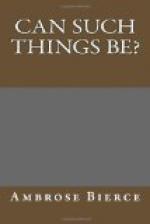For a long distance the road had been bordered by fields on both sides, but now on the left there was a forest of oaks, madronos, and gigantic spruces whose lower parts only could be seen, dim and ghostly in the fog. The undergrowth was, in places, thick, but nowhere impenetrable. For some moments Holker saw nothing of the building, but as they turned into the woods it revealed itself in faint gray outline through the fog, looking huge and far away. A few steps more, and it was within an arm’s length, distinct, dark with moisture, and insignificant in size. It had the usual country-schoolhouse form—belonged to the packing-box order of architecture; had an underpinning of stones, a moss-grown roof, and blank window spaces, whence both glass and sash had long departed. It was ruined, but not a ruin—a typical Californian substitute for what are known to guide-bookers abroad as “monuments of the past.” With scarcely a glance at this uninteresting structure Jaralson moved on into the dripping undergrowth beyond.
“I will show you where he held me up,” he said. “This is the graveyard.”
Here and there among the bushes were small inclosures containing graves, sometimes no more than one. They were recognized as graves by the discolored stones or rotting boards at head and foot, leaning at all angles, some prostrate; by the ruined picket fences surrounding them; or, infrequently, by the mound itself showing its gravel through the fallen leaves. In many instances nothing marked the spot where lay the vestiges of some poor mortal—who, leaving “a large circle of sorrowing friends,” had been left by them in turn— except a depression in the earth, more lasting than that in the spirits of the mourners. The paths, if any paths had been, were long obliterated; trees of a considerable size had been permitted to grow up from the graves and thrust aside with root or branch the inclosing fences. Over all was that air of abandonment and decay which seems nowhere so fit and significant as in a village of the forgotten dead.
As the two men, Jaralson leading, pushed their way through the growth of young trees, that enterprising man suddenly stopped and brought up his shotgun to the height of his breast, uttered a low note of warning, and stood motionless, his eyes fixed upon something ahead. As well as he could, obstructed by brush, his companion, though seeing nothing, imitated the posture and so stood, prepared for what might ensue. A moment later Jaralson moved cautiously forward, the other following.
Under the branches of an enormous spruce lay the dead body of a man. Standing silent above it they noted such particulars as first strike the attention—the face, the attitude, the clothing; whatever most promptly and plainly answers the unspoken question of a sympathetic curiosity.
The body lay upon its back, the legs wide apart. One arm was thrust upward, the other outward; but the latter was bent acutely, and the hand was near the throat. Both hands were tightly clenched. The whole attitude was that of desperate but ineffectual resistance to— what?




